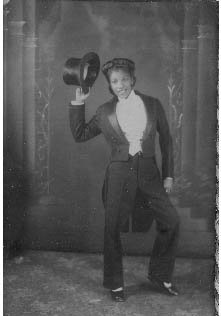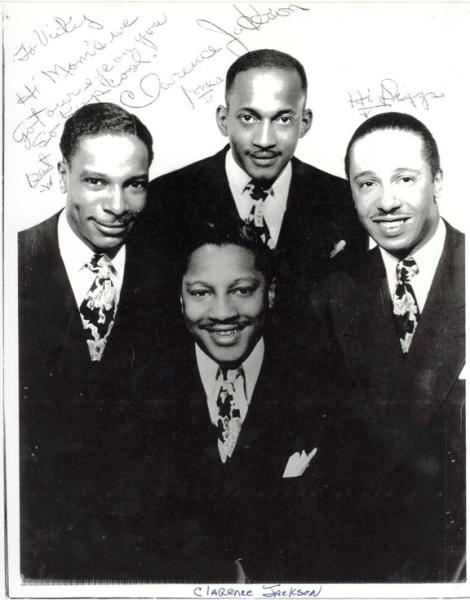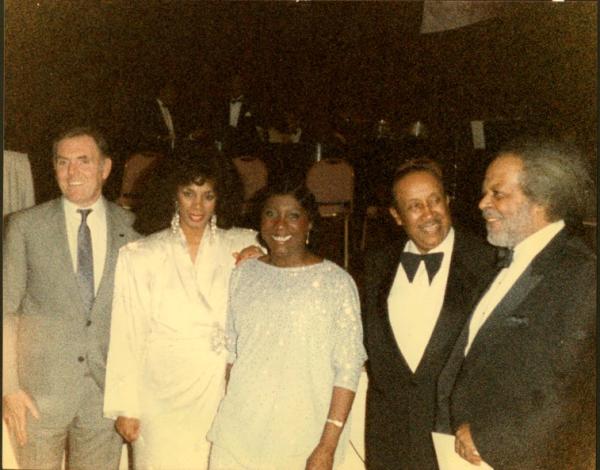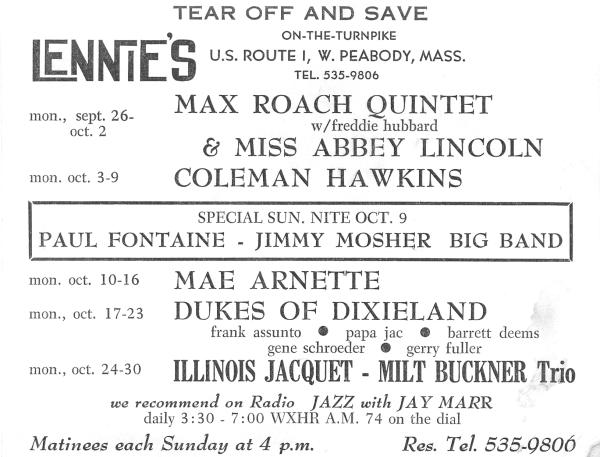Mae Arnette’s Musical Scrapbook
"Like Hearing Angels’ Voices"
My parents were in show business in New York City, where I was born. My father was a drummer, and for a time in the 1940s, he managed Luckey’s Rendezvous, on St. Nicholas Avenue and 149th Street in Harlem. Luckey Roberts, one of the great New York piano men, owned it. My mother was a dancer. She changed careers, though, and became an ordained minister. Growing up, I sang in church choirs and gospel groups.

That’s me at the piano at the age of 3, |

By the time I was 12, |
I studied classical music at the High School for Music and Art, and I played some piano and studied dance, but mostly I trained as an opera singer. At that time, I was a member of the New York All City Chorus, and the musical high point of that time was singing with the chorus on the stage at Carnegie Hall. The director was Peter J. Wolhowski. It was all high school students, and you never heard anything more beautiful, like hearing angels’ voices. We performed at Carnegie Hall, and that was a thrill to stand on that stage looking out... with the fantastic acoustics... We learned things like Carmen, Rigoletto, La Traviata... I loved it.
Outside of school, I started my performing career... and it wasn’t opera. My first professional engagement was at a place called Murrain’s on 7th Avenue in Harlem, singing opposite the Delta Rhythm Boys, who were very popular then in movies and on Broadway.
The Boston Scene in the 1950s
In 1952, I came to Boston to perform for the first time. I had an uncle in the music business living in Boston, and he sent for me to replace Ida James, the headliner in a show at Sugar Hill. That was a popular nightclub on Broadway, where the Radisson is now. I had just won the Harlem Amateur Hour, and he knew I was a singer, so he said "get her up here!" That was the first time I sang with the Sabby Lewis band, in that show. And I liked Boston, with its cobblestone streets... if you come from New York, this is like a miniature town, with its winding, narrow streets. I just fell in love with it and decided to move here. But I held on to my apartment in Harlem for years, going back and forth, sometimes flying down and back on the same day.
I studied classical music at the High School for Music and Art, and I played some piano and studied dance, but mostly I trained as an opera singer. At that time, I was a member of the New York All City Chorus, and the musical high point of that time was singing with the chorus on the stage at Carnegie Hall. The director was Peter J. Wolhowski. It was all high school students, and you never heard anything more beautiful, like hearing angels’ voices. We performed at Carnegie Hall, and that was a thrill to stand on that stage looking out... with the fantastic acoustics... We learned things like Carmen, Rigoletto, La Traviata... I loved it.
Boston was thriving then musically, and here are a few pictures of some of the groups and artists who were around Boston when I arrived in 1952.

Clarence Jackson and His Notes of Rhythm, are in the photo on the left, taken in late 1940s. Clockwise from left, the band is Clarence Johnson, guitar; George Jones, bass; Hi Diggs, piano; Clarence Jackson, drums and vocals. |

In the photo on the right is Lloyd Trotman, the bassist. His family has deep jazz roots in Boston; his father Lambert was a well-known music teacher, and both his brothers, Ernie and Stanley, were good piano players. |

|

|

|

|
On one of those nights in 1979, the legendary Bricktop (Ada Smith) came by. She was a longtime associate of Josephine Baker, one of my early influences, and she lived quite a life. She was a stage entertainer and ran nightclubs in Paris, Rome and Mexico City, and she knew everybody.

One good Lulu’s story. It was 1978, and I was set to bring my show into Lulu’s, but I was having a little trouble with the ownership, they wanted to make some cast changes to the show, and I was thinking of cancelling. Then we had the big blizzard, and after a week people were going crazy, being housebound. Everybody wanted to go out again! And I talked to the owner, and he said "you can’t cancel, I’ve got reservations, for a party of ten, a party of twelve. " So we worked things out and we did the show and the place was packed. He had to go out for extra chairs. We sold out, had a line down Appleton Street. Peter Falk, Columbo, called, he couldn’t get in, he wanted a ticket. Everybody wanted a ticket. That was some show.
There were other clubs around at that time where I worked, like the Merry-Go-Round in the Copley Plaza Hotel, and Estelle’s on Tremont Street. I had a particularly good trio then, with Dave Stewart on piano, Richie Reid on bass, and Akira Tana on drums. You can read a review of one of our performances at the Merry-Go-Round in Al Julian's 1977 article in Nightlife magazine.
More Jazz Pictures from the Scrapbook
Here are pictures of jazz friends collected over the years. The first two were taken at the Jazz Workshop on Boylston Street in Boston, and Boston Bernie Moss is in both of them, on the left with Horace Silver and on the right with McCoy Tyner. Usually Bernie was taking the pictures, so I was pleased to be photographing the photographer.

|

|

|

|
On the left is Maxine Sullivan, she came by when I was at the Scotch & Sirloin on North Washington Street. I was there with Vic Dickenson, and Al and Buzzy Drootin. On the right is Teddy Wilson, taken when we were working together in New Hampshire in the early 1980s.

That’s Freddie Cole, Nat’s brother, who went to school in Boston and spent quite a bit of time here.

That’s Teddi King, another fine Boston singer, in the photo on the left, taken at the Scotch & Sirloin. |

The picture with Tony Bennett was taken at Symphony Hall, in 1990 when he sang with the Basie band. |
The gentlemen on the right are both members of the New England Jazz Hall of Fame, and two of the finest musicians I ever worked with, Sabby Lewis and Jaki Byard. At the other end of the picture is the former mayor of Boston, Ray Flynn. Next to him is Donna Summers. The occasion for the picture was the first Martin Luther King Music Achievement Award ceremony, at the Park Plaza Hotel in 1988. Besides Sabby, Jaki, Donna and me, Roy Haynes was also presented the award on this night.

It Wasn’t All Jazz Singing
Stage work is second nature to me, and when I lived in New York, I worked in theatre both on and off Broadway. (I was Claudia McNeil’s understudy in the Broadway production of the Langston Hughes play, Simply Heavenly, and to make the world a little smaller, Claudia McNeil was a waitress at Luckey’s Rendezvous years before.) In Boston, in 1983, I played Henrietta Cook, the lead in Kurt Tucholsky’s Berlin Cabaret, at the Next Move Theatre.

|

|
On the left is the credits page from Berlin Cabaret, and on the right is the cast picture.
My Fling with Network Television
I had some experience on television, on Dave Garroway’s program, and locally on the Say Brother show, but in 1983 I appeared in an episode of the popular drama, Trapper John, M.D. I went to Orlando, Florida and ended up taking a screen test, sponsored by Six Flags and 20th Century Fox. There were 8,000 contestants nationwide, and I won! The prize was a role in the show. They flew me to Hollywood, and we filmed the show at Fox Studios in February 1983, for broadcast in April. I was in Hollywood, and I was thrilled.

There’s Always More to the Story
Here are a few more of my experiences in and around music. In the 1970s, I joined the vocal faculty at the Community Service Department of the New England Conservatory of Music. We staged a production of The Wiz one year and built the set out of anything that shined... I even went down to Filene’s department store and asked for materials from merchandise displays to use in our backdrops.
I spent a summer as an entertainment coordinator for the Mayor’s Department of Cultural Affairs, on the Summerthing program.
Jazz festivals... I sang at Newport, and in Sweden with Scott Hamilton at the Stockholm Jazz Festival, and in some of the local festivals, in Marblehead and at the Boston Globe Jazz Festival in 1981 in the big Duke Ellington tribute.
I was one of the original organizers of the "Steppin’ Out" shows, to benefit the Dimock Community Health Center in Roxbury. You can read a review of the first one, in 1988, in John Brenner's article in the Boston Post-Gazette.



